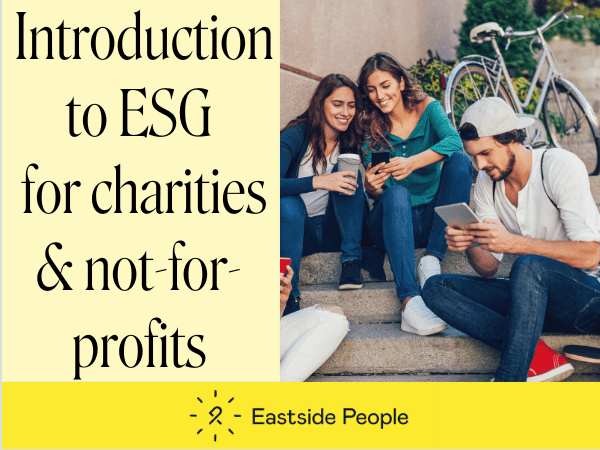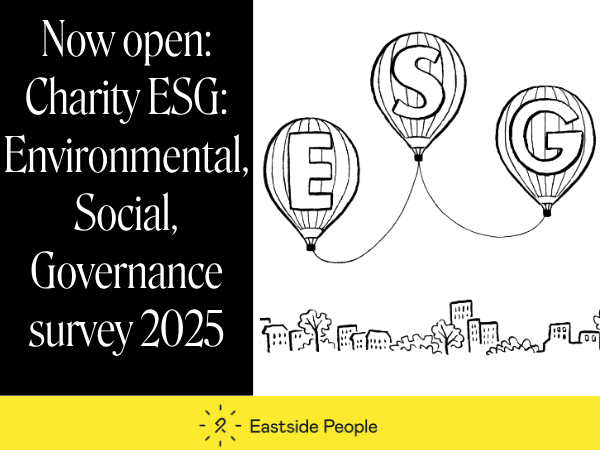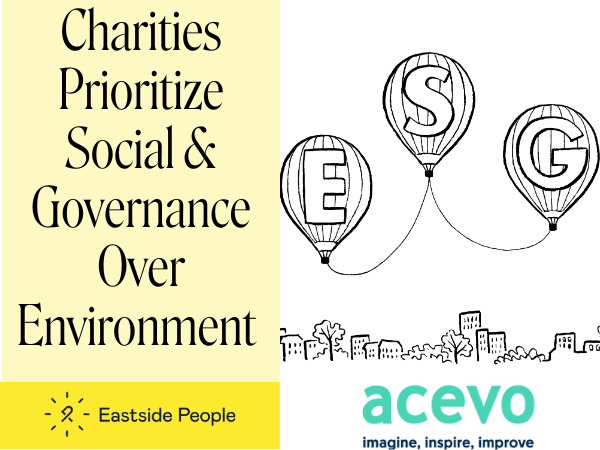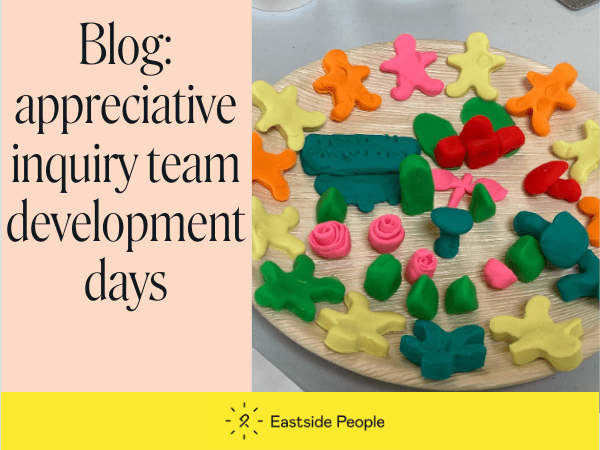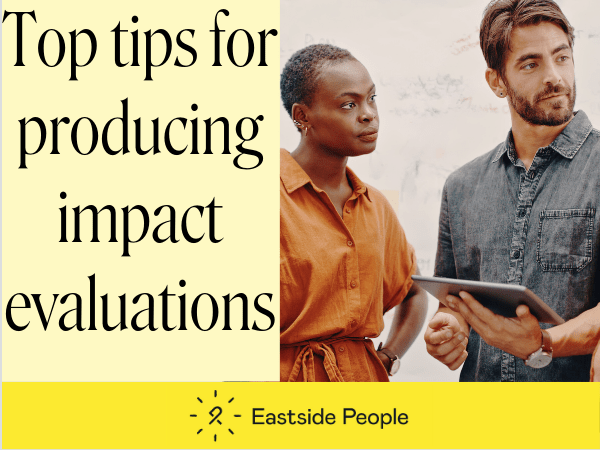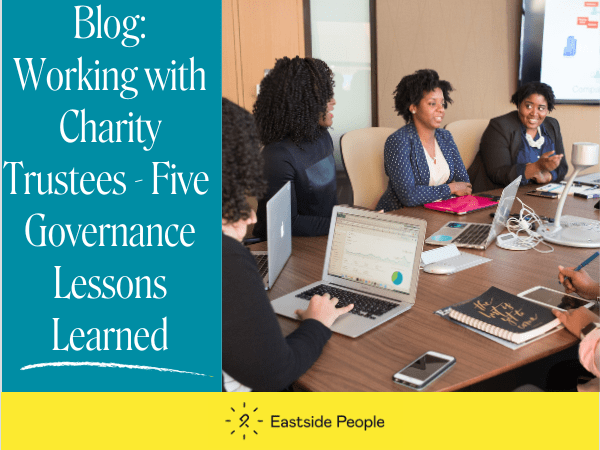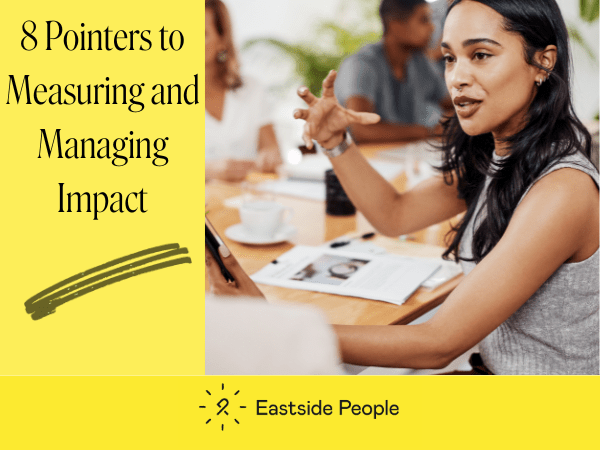Questions answered by Eastside People’s CEO Richard Litchfield.
Edition 1 of our free ESG survey and reporting tool for charities and social enterprises was available for completion during September and October 2024. Once the reporting period had ended, we analysed the results and provided individual reports to all the organisations that took the time to complete the questions.
On 29th January 2025, we held a webinar to launch the overall report findings (along with our ESG partner ACEVO). During the session, we presented data from the first year of results and highlighted trends and insights that we found particularly pertinent for the sector.
During the webinar, a number of insightful and interesting questions were asked. Here are our responses to them:
Charity ESG Research Q&A
Q1: I wondered whether there has there been any conversation about connecting ESG goals with B Corp certification within the charity sector? A second similar question asked since the UN sustainable development goals are a well-known tool, why didn’t we choose to be more closely aligned with these?
A1: These questions relate to methodology and avoiding multiplicity. In the first place, we reviewed a range of comparable standards and frameworks including the UN Sustainable Development Goals (SDGs) in order to design our survey.
Wherever possible we didn’t want to recreate or duplicate and so were driven by the principle to start where charities are and contextualise for the sector. In relation to the S & G areas, we referred to CIPD’s 7 pillars of Good Work, Harvard’s Review 5 Stages of EDI Maturity and the Charity Governance Code. The UN SDGs are broader and less immediately applicable, but it is fairly easy to align each part of our self-assessment survey with them (note there is a sister ESG project in social housing which does this).
In each section of E, S and G, we also asked organisations about what frameworks and standards each organisation is currently using. We have collated this data and are sharing it back with the 78 organisations who completed the 1st edition of the survey in an effort to understand the breadth and to sign-post what others are finding most useful.
In the future we will continue to seek to align with universal standards where sensible. Our survey and the action plan provides a way for charities to measure and manage their ESG. It is therefore not at all incompatible that an ESG strategy will also have actions about applying for standards or marks (e.g. B Corp) which aid development and improvement.
Q2: Is there data on those who are setting goals and have indicated they want to make change vs those with budget set aside for this and how much they are looking to spend on this activity?
A2: We didn’t explicitly ask about budgets in 2024, although there are some specific areas where we asked whether organisations had costed their targets/plans. We are intending to update the survey year on year, so this is something we could add in year 2 onwards.
Q3: With the reported 67% of organisations having no strategy for ESG, how were they determining their level of progression in the ‘maturity’ (progress) axis of the question set? Was there a universal benchmark introduced in the survey?
A3: We provided a structure for maturity against four stages:
- Starting Out
- Developing
- Advancing
- Advanced.
In each of these stages we described what was expected. You can see the descriptions in the appendix of the report. To bring this to life, starting out was concerned with having an intention to start, while advanced would require not just doing something well but also having evidence and embedding it culturally.
We worked hard on the language of each question within E, S and G areas to make it as clear as possible. This meant that you didn’t need to have a ESG strategy to be ready to complete this survey. Continuous development will be important here. As part of 2025 survey we will be reviewing the specificity of questions and the guidelines available. We may for instance add questions as drop-downs particularly for those that can benefit from more granularity.
Q4: Really keen to understand if charities are considering their carbon impact across scope 3 as well as scope 1 and 2 and for those who are setting carbon reduction targets, how they are approaching setting these targets and over what timeframe?
A4: Larger charities with turnover above £42m (€50m) or those contracting over £5m with the NHS have to follow requirements to report a sub-sect of scope 3 activities and a carbon reduction plan. In the survey we found that charities measuring their carbon footprint didn’t tend to have a clear plan of how to meet net zero targets. What was more common is intermediate targets of reducing emissions by 5-10% by 2030.
Q5: What financing options are available for charities/social enterprises looking to implement energy saving measures and is there any data on the different financial tools used e.g. grants, fundraising, social investment etc?
A5: There are a range of different financing models – and we expect more to come on stream over the next couple of years. Larger charities with reserves are self-funding what we describe as ‘invest to save’ programmes. This is often when they have a property portfolio and savings can be identified from improving efficiencies. Some other organisations are seeking social investment. As an example the Energy Resilience Fund from Social Investment Business is worth looking at. It provides a blended funding package of loan (60%) and grant (40%) to bolster the energy resilience of eligible charities and social enterprises in England. It is delivered by a partnership made up of Social Investment Business, Big Issue Invest, Charity Bank, Co-operative and Community Finance, Groundwork UK, Key Fund, Resonance Ltd, The Architectural Heritage Fund,and The Ubele Initiative.
Q6: Was any concern expressed in the survey about political resistance to EDI, environmental impact, etc. affecting organisations?
A6: We did not pick up any comments about political issues although it’s worth noting that the survey was undertaken in a 5-week period in September/October 2024, and therefore before the start of the new US administration and perhaps at a time when there was less overt visibility and pressure on EDI programmes.
Q7: As charities supporting other charities is not something we do very well (in my view), which environmental charities could we all support by using their services?
A7: This is a great question / point. Wikipedia has a list of some of the Environmental Charities based in the United Kingdom which may be useful for anyone wishing to explore this option.
Q8: An interesting point re the requirements of Commissioners/contracts – is this going to be an increasing trend and link to funding?
A8: In short – yes! The trajectory and importance will vary on the type of commissioner or funder. Social value is commonly now required of those bidding for public sector contracts. Due to social value legislation being included in the new Procurement Act, there is a legal requirement for public sector buyers to shift from awarding contracts based on M.E.A.T (Most Economically Advantageous Tender) to M.A.T. (Most Advantageous Tender).
This means considering the wider benefits for the community in which the contract will be delivered, such as local employment opportunities, carbon emissions reduction or choosing a local rather than a national or overseas supply chain – all of which can contribute to Social Value.
Buyers now have an integral role to play in ensuring that their organisation’s supply chain has clear sustainability and Social Value performance, so setting out clear expectations at the contract stage is critical to managing the ongoing relationship.
Companies will therefore be looking to measure and demonstrate the social and environmental risks of their supply chains. We believe this reporting requirement will be passed down to charities. Those who want to partner with businesses will need to demonstrate that they are monitoring and managing their ESG.
Trusts and foundations are likely to adopt a variety of approaches. A subset want to understand the environmental sustainability of charities. Almost all will be asking some questions around social and governance performance. Our view is that any organisation with a robust way to measure and manage their ESG will be better positioned to meet the reporting needs of a variety of funders and stakeholders.
Q9: More of a comment than a question. Seems to me that the report provides good evidence to go to funders/the Government seeking support for more environmental measures. The will is clearly there but not the means!
A9: Yes indeed. As part of our next steps, we would like to mobilise a Funders Network which can support this project and the wider need for charities to receive support to measure and manage their ESG. The development costs required to enable a charity to move from ‘Starting Out’ to ‘Advanced’ in any given area might be substantial and will otherwise need to come from a charity’s core costs budget.
Q10: Would it be helpful to look for best practice goals depending on size? For example, paying the real living wage might be a basic standard for all charities, while charities of a £150m turnover, might have much higher standards of best practice around environmental issues.
A10: Size is definitely a factor in the different risks and opportunities which organisations face regarding their ESG footprint. Large charities with complex operations will have very different footprints than small organisations. Those with property portfolios will vary significantly from those without. Office based vs remote working is another dimension to be considered.
However, what was also very interesting in the survey is that size wasn’t a very good predictor of how well advanced an organisation might be. Take for instance the workforce (part of the ‘S’) where a large organisation with better financial stability might be able to offer higher pay, but a smaller organisation might be better at engaging with staff, being collaborative and flexible.
In this year’s report, we’ve signalled the size of organisations when naming good practice so our hope/intention is that you can choose what is most relevant. However, going forward we would like to add more context and nuance – and find better ways to show case good practice. Ideally this would involve linking good practice to shared features such as charities which are asset-holding, share same level of maturity, operate in same sub-sector/causes etc.
You can download the full ESG report and sign up to complete the next edition of the survey when it reopens on 27th May 2025 here.
Learn more about our ESG consultancy services or get in touch today.



